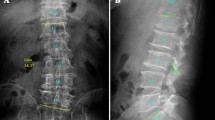Abstract
The paraspinal muscles have been implicated as a major causative factor in the progression of idiopathic scoliosis. Therefore, the objectives of this preliminary study were to measure the electromyographic activity (EMG) of the paraspinal muscles to determine its relationship to progression of the scoliotic curve. Idiopathic scoliotic patients were selected and identified afterwards on curve progression. The EMG activity on both sides of the spine was measured in a set of standardized postures using bipolar surface electrodes at the apex and two end vertebrae of the scoliotic curve. An EMG ratio involving measurements of the EMG activity on the convex and concave sides of the scoliotic curve was used to evaluate the paraspinal muscles. Enhanced EMG ratios at the apex of the scoliotic curve were found in both groups during sitting and standing. The most interesting finding was that children with progression of the curve also showed enhanced EMG ratios at the lower end vertebra of the curve. The EMG ratios between the groups were significantly different from each other at the apex and end vertebrae for several test conditions. Overlap in the EMG-ratio ranges made differentiation difficult for prediction of the progression of the individual scoliosis patient. However, the EMG ratio at the lower end vertebra of the scoliotic curve is significantly higher than 1 in all test conditions in the group of children with subsequent progression of the curve, whereas it is always normal in the non-progressive group. Therefore, EMG of the paraspinal muscles might be of value for prediction of progression in idiopathic scoliosis.



Similar content being viewed by others
References
Alexander MA, Season EH (1978) Idiopathic scoliosis: an electromyographic study. Arch Phys Med Rehabil 59:314–315
Butterworth TR, James C (1969) Electromyographic studies in idiopathic scoliosis. South Med J:1,008–1,010
Cheung J, Wever DJ, Veldhuizen AG et al (2002) The reliability of quantitative analysis on digital images of the scoliotic spine. Eur Spine J 11:535–542
Cobb JR (1948) Outline for the study of scoliosis. Instructional course lectures. Am Acad Orthop 5:261–275
Güth V, Abbink F, Götze HG, Heinrichs W (1976) Kinesiologische und elektromyographische untersuchungen über die wirkung des Milwaukee-korsetts. Z Orthop Ihre Grenzgeb 114:480–484
Henssge J (1980) Electromyographischer beitrag zum skolioseproblem. Z Orthop Ihre Grenzgeb 99:167–195
Hopf CH, Scheidecker M, Steffan K, Bodem F, Eysel P (1998) Gait analysis in idiopathic scoliosis before and after surgery: A comparison of the pre- and postoperative muscle activation pattern. Eur Spine J 7:6–11
Hoppenfeld S (1974) Histochemical findings in paraspinal muscles of patients with idiopathic scoliosis. In: Zorab PA (ed) Scoliosis and muscle. Heinman, London, pp 113–114
Lindström LH, Magnusson RI (1977) Interpretation of myoelectric power spectras: a model and its applications. Proc IEEE 65:653–662
Lonstein JE, Carlson JM (1984). The prediction of curve progression in untreated idiopathic scoliosis during growth. J Bone Joint Surg Am 66:1,061–1,071
Redford JB, Butterworth TR, Clements EI (1969) Use of electromyography as a prognostic aid in the management of idiopathic scoliosis. Arch Phys Med Rehabil 50:434–438
Reuber M, Schultz A, McNeill T, Spencer D (1983) Trunk muscle myoelectric activities in idiopathic scoliosis. Spine 8:447–456
Riddle HFV, Roaf R (1955) Muscle imbalance in scoliosis. Lancet 1:1,245–1,247
Spencer GSG, Zorab PA (1976) Spinal muscle in scoliosis, part I: histology and histochemistry. J Neurol Sci 30:137–142
Spencer GSG, Zorab PA (1976) Spinal muscle in scoliosis, part II: The proportion size of type I and type II skeletal muscle fibers measured using a computer-controlled microscope. J Neurol Sci 30:143–154
Tanchev PI, Dzherov AD, Parushev AD, Dikov DM, Todorov MB (2000) Scoliosis in rhythmic gymnasts. Spine 11:1,367–1,372
Türker KS (1993) Electromyography: some methodological problems and issues. Phys Ther 698–710
Valentino B, Maccauro L, Mango G, Melito F, Fabozzo A (1985) Electromyography for the investigation and early diagnosis of scoliosis. Anat Clin 7:55–59
Weerden v TW (2000) EMG recordings of the scoliotic spine. A pilot study. Personal communication
Wynarsky GT, Schultz AB (1989) Trunk-muscle activities in braced scoliosis patients. Spine 14:1,283–1,289
Yarom R, Gordon CB (1979) Muscle pathology in idiopathic scoliosis. Israel J Med Sci 15:917–924
Yarom R, Gordon CB (1979) Studies on spinal and peripheral muscles from patients with scoliosis. Spine 4:12–21
Zetterberg C, Björk R, Örtengren R, Anderson GBJ (1984) Electromyography of the paravertebral muscles in idiopathic scoliosis: measurements of amplitude and spectral changes under load. Acta Orthop Scand 55:304–309
Zuk T (1962) The role of spinal and abdominal muscles in the pathogenesis of scoliosis. J Bone Joint Surg Br 44:102–105
Acknowledgments
The authors thank Dr. Tom W. van Weerden for his contribution to the discussion and Ronald Davidsz for his technical support. This work was supported by STW (Netherlands Technology Foundation)
Author information
Authors and Affiliations
Corresponding author
Rights and permissions
About this article
Cite this article
Cheung, J., Halbertsma, J.P.K., Veldhuizen, A.G. et al. A preliminary study on electromyographic analysis of the paraspinal musculature in idiopathic scoliosis. Eur Spine J 14, 130–137 (2005). https://doi.org/10.1007/s00586-004-0780-7
Received:
Revised:
Accepted:
Published:
Issue Date:
DOI: https://doi.org/10.1007/s00586-004-0780-7




